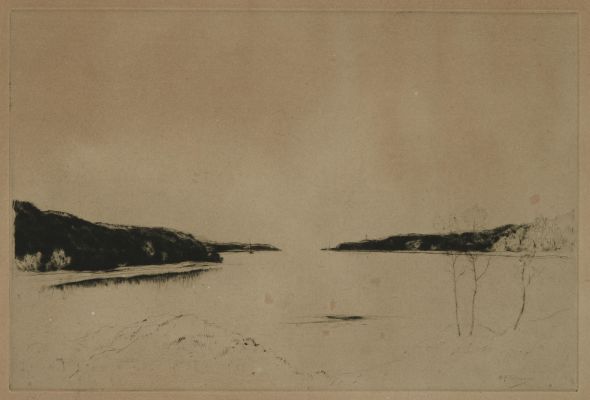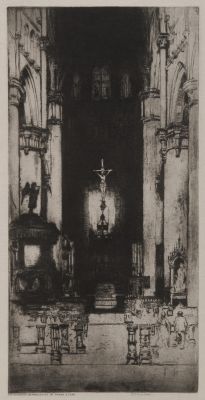
Title
The Chapel and Founders Tomb CharterhouseArtist
Cameron, D.Y. (Scottish, 1865-1945)Date
1894Process
EngravingImage Size
8.6 x 13.2 cmSheet Size
17 x 23 cm
His work is true to his country, reticent, reserved, weird, and tenderly beautiful D.Y. Cameron re James Craig Annan [1]
During the mid-nineteenth century, etching experienced a widespread revival in Europe and the United States, a movement that came to be known as the etching revival. The father of the revival in Britain was Francis Seymour Haden, the surgeon etcher, who, with his brother-in-law, the American, James McNeill Whistler, produced a body of work that still stands as one of the high points of etching history. One of their most important contributions was their ability to create surface tone, not just through fineness and density of lines but also by various means of expressive inking and wiping of the printing plate.
Etchings are produced by sketching upon a malleable wax ground instead of carving into a copperplate. It therefore more closely resembles the practice of drawing and is seen as directly connected to the artist’s hand. Etchers were also often more involved in the printing of their works, and could select inks, papers, or processes themselves or in collaboration with a master printer. These qualities led etching to be viewed as more authentic, artistic, and expressive than other printmaking processes.
D.Y. Cameron, an active participant in the revival in Glasgow, was a close friend of James Craig Annan. In 1894, the year Cameron made this engraving, he and Annan traveled through Italy together working side by side. Their symbiotic working relationship blurred the line between the etching and the pictorial photograph which Annan employed through the photograph’s etched equivalent, the photogravure.
From Annan’s perspective, the challenge for the artist-photogravurist was to introduce, into the technical constraints of photography and gravure, elements of personal artistic control. Influenced by Cameron and William Strang, another of Annan’s etcher friends, Annan’s photogravures achieve a fine balance between the ink-expression of etching and the continuous tone of the photograph, placing ‘pictorialist’ photography of the 1890s and early Twentieth Century squarely in its graphic arts context.
.
Reproduced / Exhibited
MET accession number: 17.3.3063
National Gallery of Art Accession Number 1943.3.2666
MIA accession number P.92.8.24
References
[1] D. Y. Cameron. ‘An Artist’s Notes on Mr. J. Craig Annan’s Pictures Now Being Exhibited at the Royal Photographic Society’. The Amateur Photographer, vol. 31, no. 802 (16 Feb. 1900), p. 123-24
Hammond, Anne, The Etching Revival and the Photogravure: A Graphic Aesthetic for Photography, Impact 6 International Multi-Disciplinary Printmaking Conference Bristol 2009




